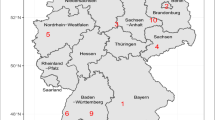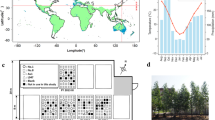Abstract
The pine wood nematode (PWN) Bursaphelenchus xylophilus is the causal agent of pine wilt disease (PWD), a xylem restricting disease of pine trees. PWN, a native of North America where it very rarely kills native pine trees, has spread internationally killing host trees in China, Japan, Korea, Taiwan and Portugal, with isolated incursions into Spain. Based on the locations where tree mortality has been recorded, it appears that pine trees growing in hot, dry conditions are more susceptible to pine wilt disease. This paper describes the ETpN model, an evapo-transpiration model (previously developed by Forest Research), which has been modified to incorporate the presence of PWN inside a tree and which predicts the regions of Europe that are likely to succumb to PWD. ETpN acts independently of the vector beetle (Monochamus spp.), predicting the likelihood of PWD on the assumption that a tree in a particular region has already been infested by the pine wood nematode. Different regions across Europe are included to investigate and demonstrate how different climates affect PWD incidence significantly. Simplified, “lite” and latency models have been developed to allow a non-specialist user to determine respectively the risk of PWD at a particular location and the likelihood of delays (latency) in expression of wilt symptoms.











Similar content being viewed by others
References
Allison PD (2008) Convergence failures in logistic regression. University of Pennsylvania, Philadelphia, PA
Burgess P (2009) Variation in light intensity at different latitudes and seasons, effects of cloud cover, and the amounts of direct and diffused light. Cranfield University, Presentation to continuous cover forestry group scientific meeting, School of applied sciences
Donald PA, Stamps WT, Linit MJ (2012) Pine wilt disease. The plant health instructor. The American Phytopathological Society, NewYork
Dropkin VH, Foudin A, Kondo E, Linit M, Smith M, Robbins K (1981) Pinewood nematode: a threat. Plant Dis 65:12
EPPO (1986) Data sheets on quarantine pests: Bursaphelenchus xylophilus. Prepared by CABI AND EPPO for the EU under contract 90/399003
(2010) Arcgis desktop: release 10. Environmental systems research institute, Redlands, CA
Evans H, Straw N, Watt A (2002) Climate change: impacts on uk forests. In: Broadmeadow M (ed) Technicl report, Forestry Commission Bulletin 125, Forestry Commission, Edinburgh
Evans S, Randle T, Henshall P, Arcangeli C, Pellenq J, Lafont S, Vials C (2003) Recent advances in the mechanistic modelling of forest stands and catchments. Technical report, Forest research annual report and accounts 2003–2004. Forest Research and the Stationery Office, Edinburgh
Halik S, Bergdahl DR (1994) Long-term survival of Bursaphelenchus xylophilus in living pinus sylvestris in an established plantation. Eur J For Path 24:357–363
Haylock MR, Hofstra N, Klein Tank AMG, Klok EJ, Jones PD, New M (2008) A european daily high-resolution gridded dataset of surface temperature and precipitation. J Geophys Res (Atmospheres). doi:10.1029/2008JD10201113
Huang M, Liang G, Gong J, Yang W (2013) Bayesian network and factor analysis for modeling pine wilt disease prevalence. J Softw Eng Appl 6:13–17
Ikegami M, Evans S, Evans HF (2009) Phrame project—plant health risk and monitoring evaluation. Technical report, Section 9, Final report. http://www.forestry.gov.uk/fr/INFD-7XRFX9
Kennedy MC, O’Hagan T (2006). http://www.tonyohagan.co.uk/academic/gem/
Kondo E, Foudin A, Linit M, Bolla R, Winter R, Dropkin V (1982) Pine wilt disease—nematological, entomological and biochemical investigations. University of Missouri, Bulletin SR, Technical report, 282
Kuroda K, Yamada T, Kazuhiko M, Tamura H (1988) Effects of cavitation on the development of pine wilt disease caused by Bursaphelenchus xylophilus. Ann Phytopath Soc Jpn 54:606–615
Landsberg J, Sands P (2011) Physiological ecology of forest production; principles. Processes and models. Academic Press, Cambridge
Maehara N, Hata K, Futai K (2005) Effect of blue-stain fungi on the number of Bursaphelenchus xylophilus (Nematoda: Aphelenchoididae) carried by Monochamus alternatus (Coleoptera: Cerambycidae). Nematology 7:161–167
Mamiya Y (1983) Pathology of the pine wilt disease caused by Bursaphelenchus xylophilus. Annu Rev Phytopathol 21:201–220
Mamiya Y (1988) History of pine wilt disease in Japan. J Nematol 20:219–226
Mota M, Vieira P (eds) (2008) Pine wilt disease: a worldwide threat to forest ecosystems. Springer, NewYork
Mota M, Braasch H, Bravo MA, Penas AC, Burgermeister W, Metge K, Sousa E (1999) First report of Bursaphelenchus xylophilus in portugal and in Europe. Nematology 1:727–734
Murray JD (1989) Mathematical biology. Biomathematics texts. Springer, NewYork
Myers RF (1986) Cambium destruction in conifers caused by pinewood nematodes. J Nematol 18:398–402
Naves PM, Sousa E (2009) Threshold temperatures and degree-day estimates for development of post-dormancy larvae of Monochamus galloprovincialis (Coleoptera: Cerambycidae). J Pest Sci 82:1–6
Naves PM, Sousa E, Rodrigues JM (2008) Biology of Monochamus galloprovincialis (Coleoptera: Cerambycidae) in the pine wilt disease affected zone, Southern Portugal. Silva Lusit 16:133–148
Oh WS, Jeong PY, Joo HJ, Lee JE, Moon YS, Cheon HM, Kim JH, Lee YU, Shim YH, Paik YK (2013) Identification and characterization of a dual-acting antinematoda, Bursaphelenchus xylophilus. PLoS One 4(11):e7593
Ohta K, Hoshizaki H, Nakamura K, Nagaki A, Ozawa Y, Nikkeshi A, Makita A, Kobayashi K, Nakakita O (2012) Seasonal variations in the incidence of pine wilt and infestation by its vector, Monochamus alternatus, near the northern limit of the disease in Japan. J For Res 17:360–368
R Core Team (2014) R: A language and environment for statistical computing. R Foundation for Statistical Computing, Vienna, Austria. http://www.R-project.org/
Riga E, Webster JM (1991) Cryopreservation of the pinewood nematode, Bursaphelenchus spp. J. Nematol 23(4):438–440
Robinet C (2014) Rephrame project—research extending plant health risk and monitoring evaluation. Technical report, Work Package 7, Third Periodic Report. http://www.rephrame.eu/
Robinet C, Van Opstal N, Baker R, Roques A (2011) Applying a spread model to identify the entry points from which the pine wood nematode, the vector of pine wilt disease, would spread most rapidly across Europe. Biol Invas 13:2981–2995
Rutherford TA, Webster JM (1987) Distribution of pine wilt disease with respect to temperature in North America, Japan and Europe. Can J For Res 17:1050–1059
Rutherford TA, Riga E, Webster JM (1992) Temperature-mediated behavioral relationships in Bursaphelenchus xylophilus, B. Mucronatus and their hybrids. J Nematol 24:04–44
Santos CS, Pinheiro M, Silva AI, Egas C, Vasconcelos MW (2012) Searching for resistance genes to Bursaphelenchus xylophilus using high throughput screening. BMC Genomics 13
Sathyapala S (2004) Pest risk analysis, biosecurity risk to new zealand of pinewood nematode Bursaphelenchus xylophilus. Technical report, Forest Biosecurity Authority, Ministry of Agriculture and Forestry
Stokes DE (1979) Pinewood nematode, Bursaphelenchus Lignicolus, a nematode pest of some pine species. Technical report, Nematology Circular No 53
Wang F, Wang Z, Li D, Chen Q (2012) Identification and characterization of a Bursaphelenchus xylophilus (Aphelenchida: Aphelenchoididae) thermotolerance-related gene: Bx-hsp90. Int J Mol Sci 13:8819–8833
Zhao BG, Futai K, Sutherland JR, Takeuchi Y (2008) Pine wilt disease. Springer, NewYork
Acknowledgments
This research was part-funded under the Seventh Framework Programme (FP7/2007-2013) under Grant Agreement no. 265483 (REPHRAME) with match funding by the Forestry Commission. We thank Catia Arcangeli\(^{\dagger }\) for her valuable advice and suggestions during the editing process, Timothy Randle\(^{\dagger }\) for his valuable advice throughout the project, and Paul Henshall\(^{\dagger }\) for assisting with programming. \(^{\dagger }\)Forest Research, Alice Holt Lodge, Farnham, Surrey, GU10 4LH. The authors also acknowledge the E-OBS dataset from the EU-FP6 project ENSEMBLES (http://ensembles-eu.metoffice.com) and the data providers in the ECA&D project (http://www.ecad.eu)
Author information
Authors and Affiliations
Corresponding author
Rights and permissions
About this article
Cite this article
Gruffudd, H.R., Jenkins, T.A.R. & Evans, H.F. Using an evapo-transpiration model (ETpN) to predict the risk and expression of symptoms of pine wilt disease (PWD) across Europe . Biol Invasions 18, 2823–2840 (2016). https://doi.org/10.1007/s10530-016-1173-7
Received:
Accepted:
Published:
Issue Date:
DOI: https://doi.org/10.1007/s10530-016-1173-7




